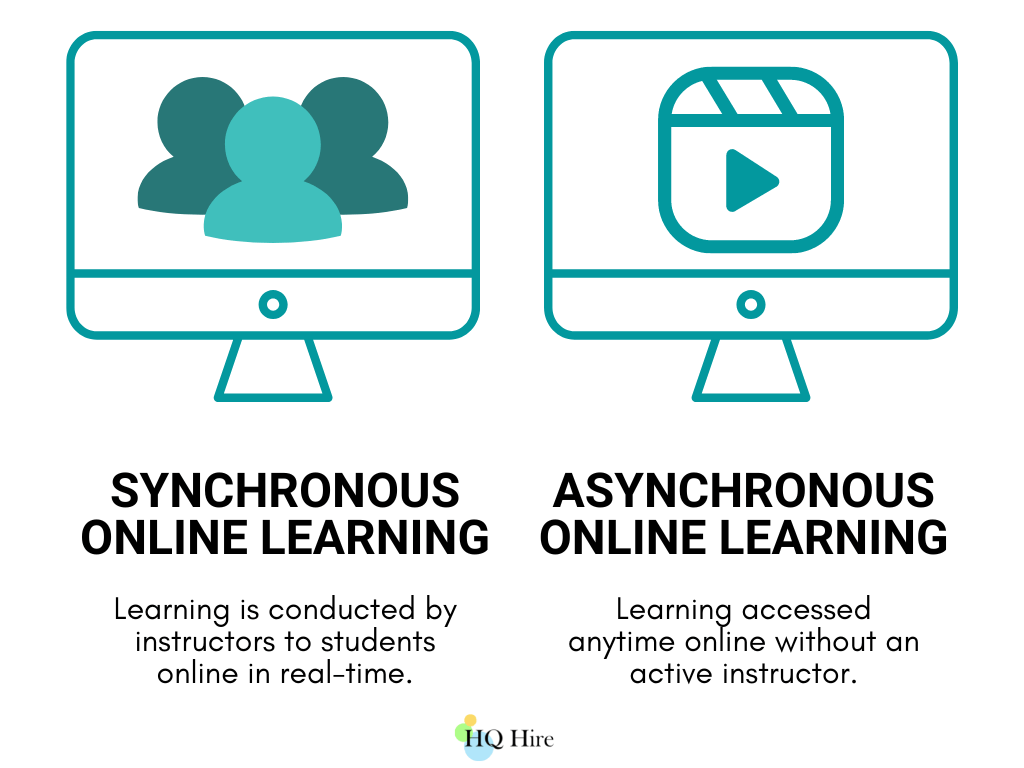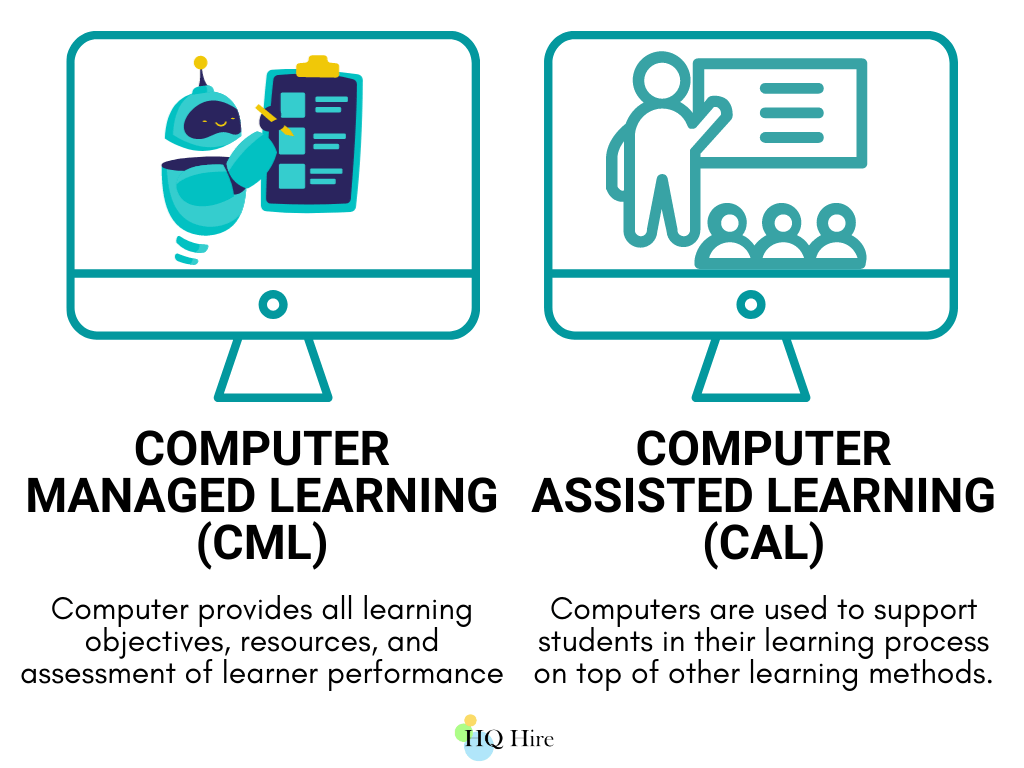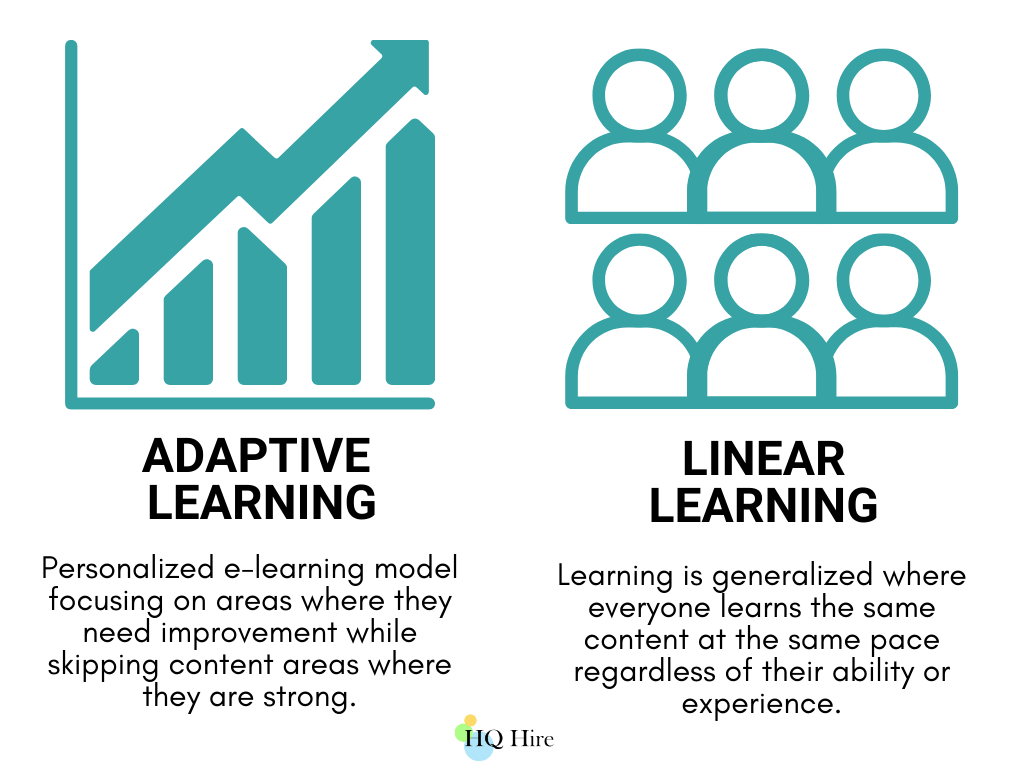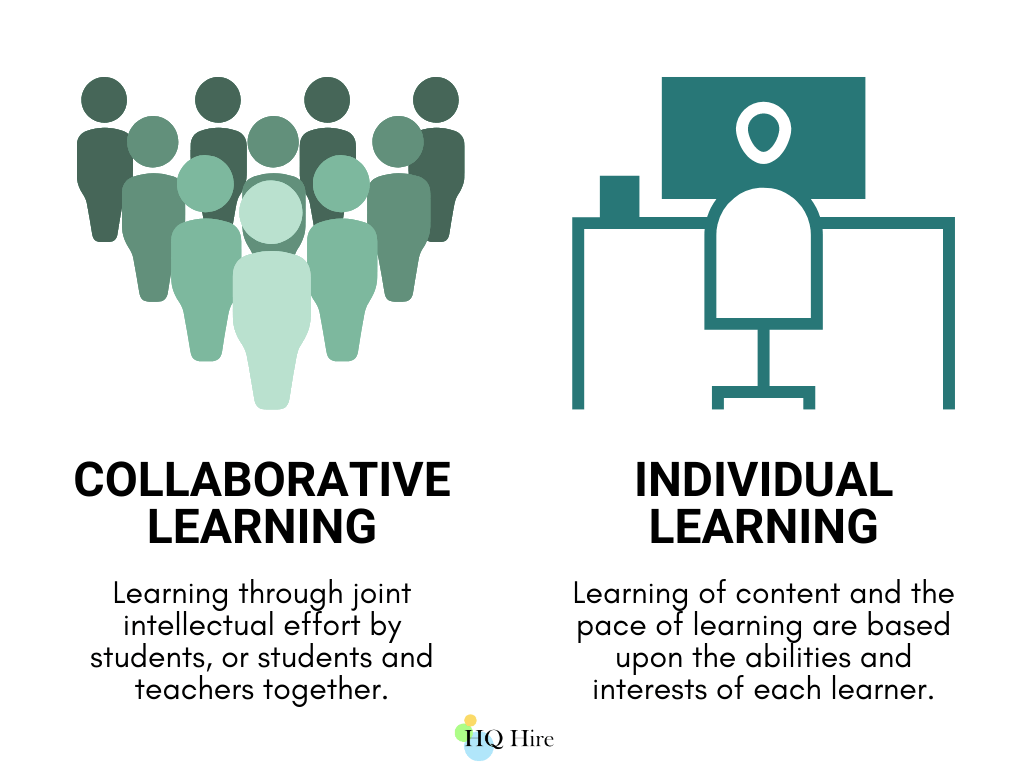With evolution of LMS, online learning is becoming an educational standard throughout the world. More teachers and educators have employed much resourcefulness in developing methods that provide the ultimate learning experience for their students.
Amount the different types of online learning, there are a few types of online learning which are more common than others,
- Synchronous learning and asynchronous learning
- Computer-Assisted Learning (CAL) and Computer-Managed Learning (CML)
- Open-schedule learning and fixed-time learning
- Hybrid learning and interactive online learning
- Adaptive e-learning and linear e-learning
- Collaborative learning and individual learning
However, each individual has a different learning style, and the one that’s best suited to one person may not suit the other.
Depending on the desired learning objectives, some teachers and students prefer a more hands-on approach while others prefer a blend of in-person and online. Still, there are those who are not good with self-discipline and need to have in-class interaction.

Types of Online Learning
Online learning has changed the way we learn and acquire new skills. The internet provides a broad range of online courses that you can learn using online learning platforms. The opportunity to online learning has offered many benefits,
- New ways for us to learn and experience online learning.
- Chance to learn a new language anytime.
- Develop in-demanded skills anywhere.
- Build professional industrial expertise.
With the rise in popularity of online learning, we will explore the various types of online learning, discussing their advantages and disadvantages so you can decide which type of learning method is right for you.
1. Synchronous Online Learning
Synchronous Online Learning requires an instructor to interact with enrolled students online all at the same time, which differs from Asynchronous Online Learning. Very much like a webinar, participants text, audio chat, or video chat during class time.
Because of the ability to have a real feel with teachers and classmates, Synchronous Online Learning is currently the most popular form of internet education. These are, therefore, virtual classes that offer a near-tactile experience short of entering an actual classroom.
Pros of Synchronous Online Learning
- These situations enable real-time distance learning
- Removes social isolation from long-distance learning
- Mitigates poor instructor-student and student-student relationships
- Allows for quick dissemination of information with equal results in absorbing the material
- Provides a regular environment while still being flexible
Cons of Synchronous Online Learning
- Tends to be more expensive
- Not good for students with busy schedules
- Can feel less personal because the interaction isn’t the same as a real classroom
2. Asynchronous Online Learning
Asynchronous Online Learning occurs in real time but without real-time communication. Students receive assignments along with pre-recorded, pre-planned content and are given a deadline. Discussion boards, Wiki pages, and blogs provide interaction, so there are no specific meeting times.
This means students study independently according to their own schedule and the design of the classes centers around the needs of the student. Asynchronous Online Learning provides flexibility and gives students a chance to adapt to self-paced learning.
Pro of Asynchronous Online Learning
- Effective for students with strict schedules and time constraints
- Provides great schedule flexibility
- Encourages regular engagement with instructors and classmates
- Often more affordable than other types of online learning
- Pre-recorded lessons mean students can review the material as required
Cons of Asynchronous Online Learning
- Often feels less personal and distant than in an in-class setting
- Rare physical interactions with teachers and classmates
- May be difficult for some people to exude self-discipline

3. Computer Assisted Learning (CAL)
Computer Assisted Learning means using a computer to support or give aid to educational lessons, classes, or training. Also known as Computer Based Learning, Computer Assisted Instruction, and Computer Managed Instruction, CAL is not a new concept.
Actually, this has been in use since the 1960s, back then it was called, PLATO (Programmed Logic for Automatic Teaching Operations). In the olden times, people utilized record players as a learning tool.
Books on MP3s, cassettes, DVDs, and CDs all fall under the category of being a form of CAL. The versatility of this can encompass a range of educational subjects. Some of the most common ones are:
- Tutorials: These supplement an actual instructor and provide a solid outline for learning a course. This comes by way of slideshows, videos, smart device apps, and other media.
- Game-like Learning: By using fun interactivity similar to a video game, game-like learning incentivizes younger students to want to learn and master the material.
- Demonstrations: This involves the senses by incorporating auditory or visual data to immerse a student in a particular environment. Sometimes, this will use things like virtual reality or augmented reality.
- Practice: This form of learning online promotes mastery and memory recall. It’s the same as using flashcards, quizzes, or tasks in a hands-on learning environment.
Pros of Computer-Assisted Learning
- Presents an easier way to teach complex topics
- Gives immediate feedback
- Interactive and engaging
- Personalized for each student
- An abundance of chances for practice
Cons of Computer-Assisted Learning
- Can be costly to do, not often free
- Some user and administrative challenges
- Information can be outdated quickly
- There’s often a steep learning curve
- Can be distracting more than educating
- Too much reliance on instructors and students
4. Computer-Managed Learning (CML)
Computer-Managed Learning assesses and administrates each student’s learning progress. These operate via databases, which contain bits of information the student must learn within a specific set of parameters. This takes out the instructor for the most part unless it’s part of a Hybrid Online Learning protocol.
However, the instructor sets the parameters and conditions for a student to advance to the next lesson or level. This can include lectures, training materials, grading, the syllabus, enrollment data, and other relevant items. Therefore, CML is ideal for record-keeping and helping students practice.
Pros of Computer-Managed Learning (CML)
- Helps instructors track student progress
- Good for record-keeping of assignments, enrollments, and other pertinent data
- Allows for repetition and practice for students to retain information
- The computer analyzes student strengths and weaknesses to develop better learning strategies
- Continual monitoring of student learning
Cons of Computer-Managed Learning (CML)
- Impersonal and isolated way to learn
- Not good to stand on its own, it must accompany other forms of learning
- Instructors may rely too much on this rather than a hands-on experience
- Can be boring and monotonous, causing disinterest

5. Open Schedule Learning
While some classify Open Schedule Learning under the umbrella of Asynchronous Online Learning, there is a marked difference. While there’s plenty of freedom and flexibility in the coursework, students also receive things like bulletin boards, regular emails, and online textbooks.
These accompany a heavy workload and an overwhelming amount of information. Instructors give a set of deadlines, which provides a self-paced learning experience. The loose structure accommodates individual learning styles and allows students to review material at leisure.
Pros of Open Schedule Learning
- Ideal for students who love to learn on their own
- No requirement to login in at a specific time
- Flexibility and freedom for self-paced learning
- More affordable than other types of online learning
Cons of Open Schedule Learning
- Only disciplined students with a love of learning independently will benefit
- Not every person has the self-motivation required
- A very isolated way to learn
6. Fixed-Time Online Learning
As the name suggests, Fixed Time is a type of online learning that has pre-determined content, which doesn’t change and all students receive the same information. This doesn’t adapt to individual student preferences but broadcasts a strict lesson plan to every student equally.
This is what most conventional classes employ. Just like normal in-person classes, students log in to count themselves as a present for class. The lessons, assignments, and projects are at a prescribed pace set by the instructor. These will include discussion forums, chats, and other communications tools.
Pros of Fixed-Time Online Learning
- Good for students who don’t have self-discipline or motivation to work independently
- Provides immediate instructor feedback
- Gives a real feel to the classroom experience
Cons of Fixed-Time Online Learning
- It doesn’t use valuable real-time data gained from student input
- Little room for self-paced learning or schedule flexibility

7. Hybrid Online Learning
Hybrid Online Learning can manifest in several ways. While it often refers to a combination of virtual with in-person classes, it can also incorporate other types of online learning systems. For this purpose, Hybrid Online Learning refers to blending real classroom time with virtual learning.
This provides flexibility in an isolated environment. Students interact with teachers on a face-to-face basis along with emails, discussion boards, and other material received through the internet. There are a few different kinds of Hybrid Online Learning arrangements:
- Days In/Out: This requires two or three days per week online with the remaining days spent in a real classroom.
- In-Class Speaking/Out-of-Class Deadlines: Students arrive at an actual classroom to receive assignments and handouts and engage in Q and A sessions with teachers. But they submit assignments, projects, and papers online.
- Online Speaking/In-Class Deadlines: Instructors use webinars or streaming services to deliver lectures and engage in Q and A sessions. However, students turn in assignments, projects, and exams in person.
- Intermittency: Also called “Flex,” this is when students spend a portion of the quarter or semester in actual classes but also intermittently switch to online classes for extended periods.
Pros of Hybrid Online Learning
- Allows for a more tactile learning experience
- Students get real feedback from instructors and classmates
- Plenty of scheduling freedom and flexibility
- Can be just as affordable as traditional classes
Cons of Hybrid Online Learning
- Can be more difficult and challenging than traditional classes
- Some students may feel isolated if there isn’t enough in-class time
- Some people aren’t cut out for this type of online learning
8. Interactive Online Learning
While Interactive Online Learning could fall under the category of Synchronous Online Learning or Hybrid Online Learning, this is pure internet communication between two parties. Tutoring sites would be an excellent example of this.
Students and instructors/tutors communicate via email, text chat, or some other messaging platform. It allows for free communication without interruption from other students and it’s far less formal than a classroom setting, whether online or in person.
Pros of Interactive Online Learning
- Personalized and catered to student’s abilities and skills
- Direct communication between teacher-student
- Removes distractions
- Allows for changes and adjustments to suit the needs of both instructor and student
Cons of Interactive Online Learning
- May not have the ability to get lesson plans, textbooks, or other materials
- Because most situations are in text format, it presents some communication issues
9. Adaptive E-Learning
The latest online learning technique is Adaptive E-Learning. This makes it possible to redesign and adapt materials for each student. It often involves artificial intelligence or augmented reality to calculate student performance, skills, and characteristics in tandem with the teacher’s goals.
It makes a mathematical sequence of a student’s data and creates a path of learning that ensures a higher success rate for each participant. This is quite a change from traditional approaches. Adaptive E-Learning lets the teacher monitor each student and his/her progress while telling AI what to adjust and customize.
Pros of Adaptive E-Learning
- Caters coursework to accommodate individual learning styles
- Allows instructors to see and recognize patterns
- The use of AI calculates and recalibrates lessons to suit students
- Makes online learning more effective and efficient
Cons of Adaptive E-Learning
- Still in the development phases
- Can be difficult to arrange because of variable intricacies in learning styles
10. Linear E-Learning
Linear E-Learning is when information goes from the instructor to the student. There is no two-way communication and there are no assignments to submit. Classic examples of Linear E-Learning are television or radio programs that provide learning materials.
This is purely centered around the program and what the instructor devises. It can offer schedule flexibility but it does not cater to the needs and learning styles of the student.
Pros of Linear E-Learning
- Direct delivery of lectures and learning materials
- Can be flexible and offer self-paced learning
Cons of Linear E-Learning
- A very limited form of online learning
- No teacher interaction or feedback
- Becoming an outdated way to learn online

11. Collaborative Online Learning
Per the University of Missouri, Collaborative Online learning is another recent development with the potential to maintain student engagement while creating a sense of belonging to a group. This group works toward a common goal, which means students practice teamwork in order to achieve their objectives.
Therefore, students develop knowledge together with periodic feedback from instructors. Not only does this develop social skills but also good communication.
Pros of Collaborative Online Learning
- Helps mitigate the isolation students can feel in other kinds of online learning
- Aids in developing a teamwork effort
- Boosts confidence and increases the knowledge base
- Motivates students to accomplish end goals
Cons of Collaborative Online Learning
- May lack individual student performance, relying on everyone in the group to succeed
- Some students may not contribute as much as others
12. Individual Online Learning
Individual Online Learning is actually an extension of conventional classrooms. However, it refers to the achievement of learning goals rather than student-centered material. This means students study on their own with the expectation of meeting their own goals, not ones set forth by an instructor.
Pros of Individual Online Learning
- Excellent for students to customize their own course of study for unusual or uncommon subjects
- Good for students with self-discipline
- Students devise coursework
Cons of Individual Online Learning
- Not ideal for teamwork or projects requiring group effort
- Completely isolated with little to no teacher interaction

What Is Distance Learning?
Distance learning is a form of online education that is an alternative to traditional, in-person classroom instruction.
Distance learning, also known as online learning, or e-learning and is becoming increasingly popular as technology advances. It offers students the opportunity to pursue a college degree, internship or other educational qualifications from any location with an internet connection through video or audio.
As distance learning becomes a more popular form of learning, different types of e-learning evolve as the technology used for distance learning becomes more advanced.
Today, the environment where students learn has changed drastically, from a traditional classroom to hybrid learning to fully online learning. New types of technology are evolving that allow new learning experiences, making distance learning to be more seamless and more efficient. Emerging technology used for distance learning includes:
- Usage of 5G Technologies
- Augmented Reality (AR) & Simulations
- Metaverse learning allows a fully immersive learning experience
This type of learning provides flexibility and convenience, allowing individuals to study at their own pace and take courses remotely without having to relocate or even leave their homes.
Students can still interact with their teachers and fellow classmates through social networks, email, video calls, and other forms of communication channels, simulating the in-class learning experience virtually.
Read Also:
- 23 Email Etiquette: Professional Communication in Remote Workplace
- How to Do Online Meeting Follow-Up [+12 Follow-Up Meeting Email Templates]
- How to Boost Engagement During Online Meetings During (5 Meeting Engagement Strategies)
- How Write Follow-up Email [8 Email Templates and Examples]
- How to Combat Online Meeting Fatigue [Danger Signs & Solution]
Join over 11,000+ achievers who are committed to achieving their career goals!







